Key issues
- In the week ending 5 January 2025, low-pressure systems brought rainfall to the north and east of Australia:
- Excessive rainfall has led to widespread flooding across parts of North and Far North Queensland. Reports indicated that bananas and sugar cane have been affected, with growers facing damage to crops and farm infrastructure. Once flood waters begin to recede, we will get a better understanding of the impacts on other important horticultural crops.
- Some rainfall was recorded across northern cropping regions, but falls were highly variable, with between 10–50 millimetres being recorded across parts of western and northern Queensland. These falls are likely to be sufficient to support average soil moisture levels and above average summer crop yield potentials.
- Over the coming eight days, low-pressure systems and monsoon lows are expected to bring rainfall across the north and east of the country.
- Across cropping regions, Queensland is expected to receive up to 100 millimetres of rainfall, and northern New South Wales to receive up to 50 millimetres. Little to no rainfall is expected in other cropping regions.
- Most of Australia received below average to average rainfall over January 2025, with well below average rainfall across much of central Australia. Parts of the west and east saw above average rainfall.
- Pasture growth for the three months to January 2025 has been mixed across Australia. Above average rainfall totals resulted in average to extremely high pasture growth across large parts of northern Australia. Below average to extremely low pasture growth was recorded across parts of eastern and southern Australia.
- Soil moisture models indicate low soil moisture levels in much of central Australia, with above average soil moisture modelled in eastern Queensland, northern New South Wales, and large parts of Western Australia.
- Water storage in the Murray-Darling Basin (MDB) decreased between 30 January 2025 and 06 February 2025 by 409 gigalitres (GL). Current volume of water held in storage is 14 062 GL, equivalent to 64% of total storage capacity. This is 24 percent or 4,462GL less than at the same time last year. Water storage data is sourced from the Bureau of Meteorology.
- Allocation prices in the Victorian Murray below the Barmah Choke increased from $159 on 30 January to $177 on 06 February. Prices are lower in regions above the Barmah choke due to the binding of the Barmah choke trade constraint.
Climate
In the week ending 5 February, low-pressure systems and a monsoon trough brought very high rainfall to the northeast of the country. In the northwest, tropical storm systems contributed to showers and storms. High-pressure systems kept the remainder of the country largely dry.
- The northern tropics, including the Northern Territory and northern Western Australia recorded falls between 15-100 millimetres, with higher falls in isolated areas. Meanwhile, much of northern Queensland recorded falls of between 50-400 millimetres, due to the monsoon trough.
- Numerous locations across the North and Far North Queensland region have recorded more than 1 meter (1000 millimetres) of rainfall over 7-days ending 3 February 2025, leading to widespread flooding.
- Reports indicated that bananas and sugar cane have been affected by the flooding, with growers facing damage to crops and farm infrastructure. Once flood waters begin to recede, we will get a better understanding of the impacts on other important horticultural crops like mangos, avocadoes, melons and sweet corn.
- Southern Queensland, western Victoria, eastern South Australia and parts of western and eastern New South Wales received between 5–50 millimetres. Much of the remainder of country recorded little to no rainfall over the period.
Rainfall totals were generally low across cropping regions:
- Most cropping regions received little to no rainfall. The main exceptions were parts of northern and western Queensland, northern and southern New South Wales and central Victoria, which recorded between 5-50 millimetres.
- Despite the lack of rainfall across many summer cropping areas, most areas remain on track to record above average yields supported by close to average soil moisture levels for this time of year.
Rainfall for the week ending 5 February 2025
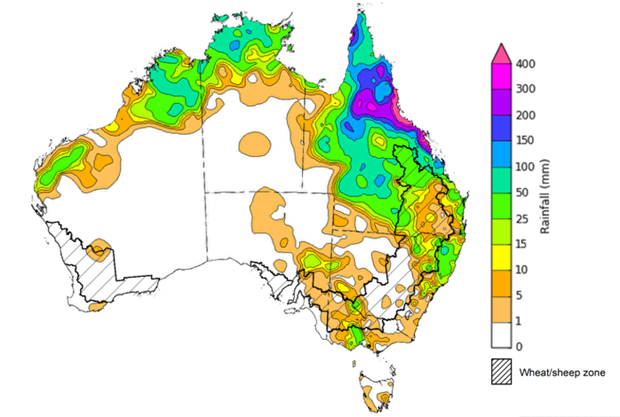
Issued: 29/1/2025
Note: The rainfall analyses and associated maps utilise data contained in the Bureau of Meteorology climate database, the Australian Data Archive for Meteorology (ADAM). The analyses are initially produced automatically from real-time data with limited quality control. They are intended to provide a general overview of rainfall across Australia as quickly as possible after the observations are received. For further information go to http://www.bom.gov.au/climate/rainfall/
Over the 8 days to 13 February 2025, monsoon lows and low-pressure systems are expected to bring rainfall over much of the north and east of Australia:
- Falls between 50–200 millimetres are likely for much of northern Western Australia, while in the Northern Territory and northern Queensland, falls are expected to be higher, between 50 to 300 millimetres.
- Across northern Queensland, if realised these high expected rainfall totals will place further pressure on flood affected areas, delaying access and hampering clean up and impact assessment activities.
- Between 10–50 millimetres are forecast for much of eastern New South Wales and Victoria, and south-eastern Queensland, with falls between 10-25 millimetres expected in Tasmania.
- By contrast, a high-pressure system is expected to keep much of the remainder of the south and interior of Australia largely dry, including South Australia and southwest Western Australia
Rainfall forecasts across cropping regions over the coming week are mixed:
- Low rainfall totals are expected in southern cropping regions, including across much of Western Australia, South Australia and Victoria (between 1–15 millimetres).
- Higher rainfall is expected in northern and eastern cropping regions, with north Queensland likely to receive between 25-200 millimetres. In New South Wales and southern Queensland, falls between 10–25 millimetres are expected. Rainfall forecast for summer cropping regions in Queensland and northern New South Wales is likely to be sufficient to support average soil moisture levels and above average summer crop yield potentials.
Total forecast rainfall for the period 6 February to 13 February 2025
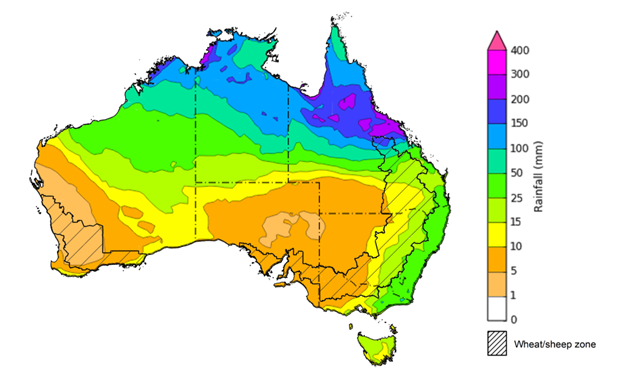
Issued 6/2/2025
Note: This rainfall forecast is produced from computer models. As the model outputs are not altered by weather forecasters, it is important to check local forecasts and warnings issued by the Bureau of Meteorology.
Large areas of central and eastern Australia received below average rainfall totals over January 2025, while coastal areas of New South Wales and northern Western Australia saw well above average rainfall over the period, relative to historical January averages.
- Rainfall was extremely low to below average across much of central Australia, including large areas of the Northern Territory, South Australia, western Queensland and western New South Wales, south-western Victoria, as well as western Tasmania and isolated areas of southwest Western Australia.
- Above average to well above average rainfall was recorded in coastal regions of New South Wales and northern Western Australia, and isolated areas of east Queensland.
- The remainder of Australia saw generally average January rainfall.
In cropping regions, January rainfall was variable, with generally below average and average rainfall in the east and average rainfall in the west
- Much of South Australia and south-western New South Wales observed well below average to extremely low rainfall.
- In Queensland, Victoria, Western Australia and the remainder of New South Wales average rainfall was experienced in most regions over the period.
Rainfall percentiles for January 2025
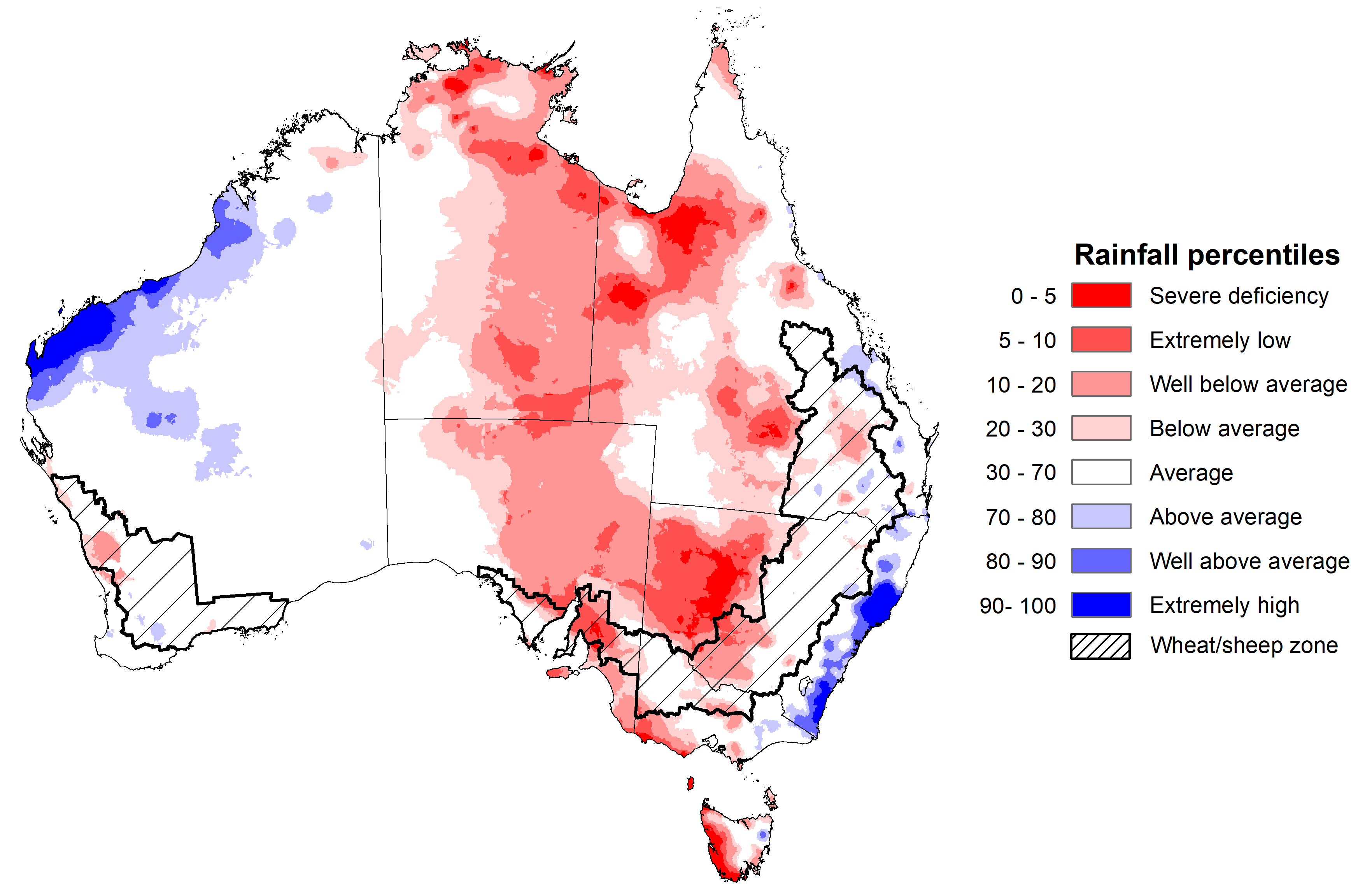
Source: Bureau of Meteorology
In January 2025, modelled upper layer soil moisture was generally below average to average across much of the country.
- Large areas of the Northern Territory, South Australia, and western regions of Queensland, New South Wales, Victoria, and Tasmania saw very much below average to below average upper layer soil moisture.
- In contrast, much of Western Australia, and eastern Queensland and New South Wales saw average to very much above upper layer soil moisture.
At this time of year, upper layer soil moisture is important for late planted summer crops in northern New South Wales and Queensland and for pasture growth across northern Australia since plant germination and establishment utilise this moisture. It is also an important indicator of the ability to access paddocks for summer crop planting activities.
Across cropping regions, modelled upper layer soil moisture in January was generally average across much of the east and west, while some cropping regions in the south saw below average soil moisture.
- In Western Australia, Queensland, Victoria and New South Wales upper layer soil moisture was broadly average, with scattered areas of above average and below average soil moisture distributed across cropping regions.
- In South Australia, western Victoria and the far southwest of New South Wales upper layer soil moisture was below average.
Average to above average upper layer soil moisture in New South Wales and Queensland is likely to have encouraged the late planting and germination of summer crops for northern cropping regions.
Modelled upper layer soil moisture for January 2025
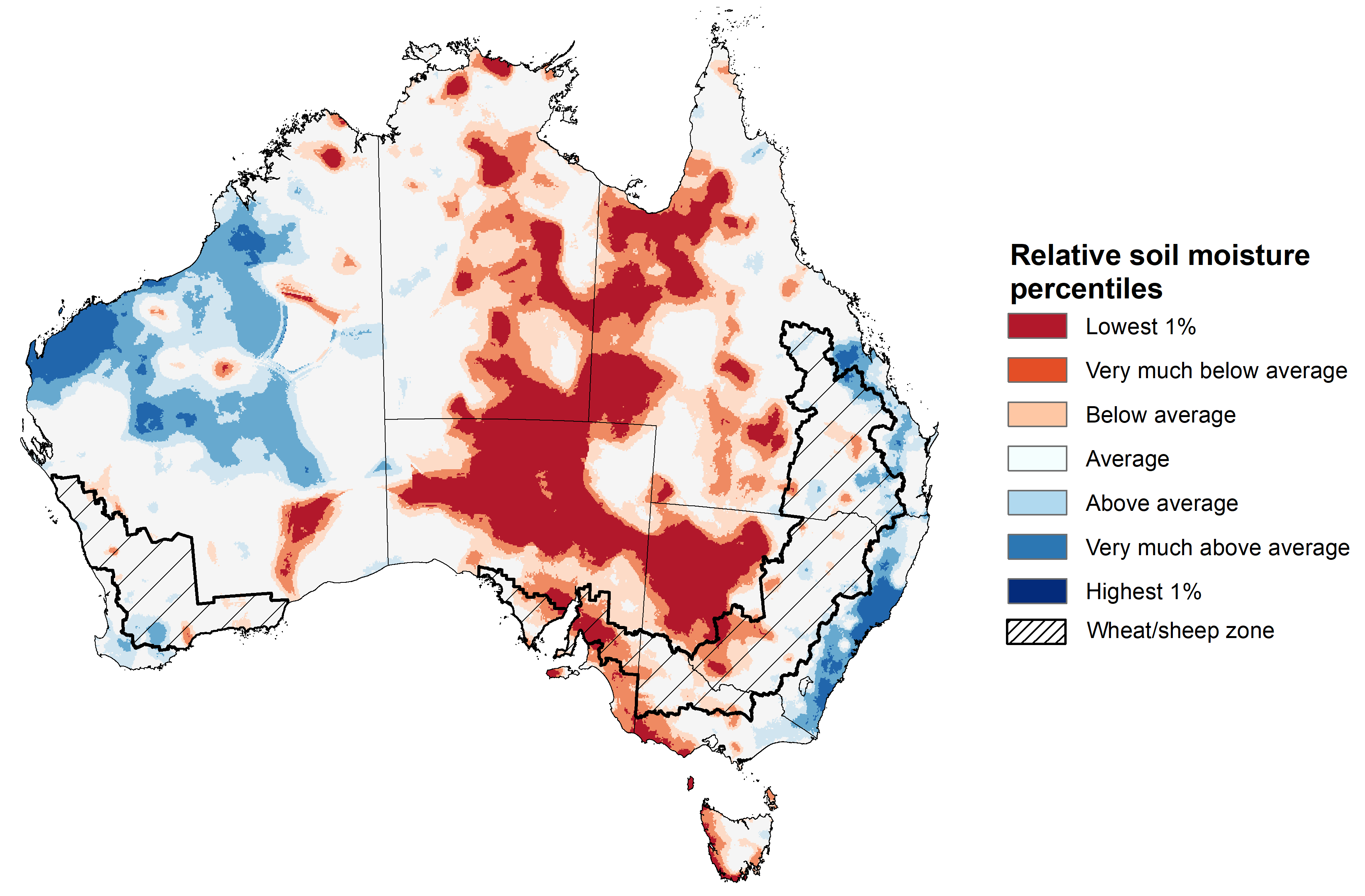
Source: Bureau of Meteorology (https://awo.bom.gov.au/about/overview)
Across much of Australia, modelled lower layer soil moisture in January 2025 was average to very much below average, with areas of above average lower layer soil moisture in the west and east of the country. This represents a considerable decline from December 2024, where much of Australia was modelled as having average to very much above average soil moisture.
- Large areas of the Northern Territory, South Australia, western Queensland and New South Wales, and south-western Western Australia were modelled as having very much below average soil moisture.
- By contrast, much of Western Australia, eastern Queensland, eastern New South Wales, and western Tasmania recorded above average to very much above average soil moisture over the period.
At this time of year increased levels of lower layer soil moisture will be important to support summer crops and pasture growth during a peak growth period.
Across cropping regions, modelled lower layer soil moisture was generally above average in the east with areas of extremely low moisture modelled in the south.
- Much of Queensland and isolated areas of central New South Wales modelled very much above average to average soil moisture.
- In contrast, South Australia, southern Western Australia, western Victoria, and southern New South Wales and southern Western Australia saw below average soil moisture for this time of year.
Average to above average lower layer soil moisture is likely to provide a reserve of plant-available water for summer crops later in the growing season. Agricultural regions across southern Australia with extremely low levels of stored soil moisture will require sufficient and timely rainfall over the remainder of summer to arrest declining levels of pasture availability.
Modelled lower layer soil moisture for January 2025
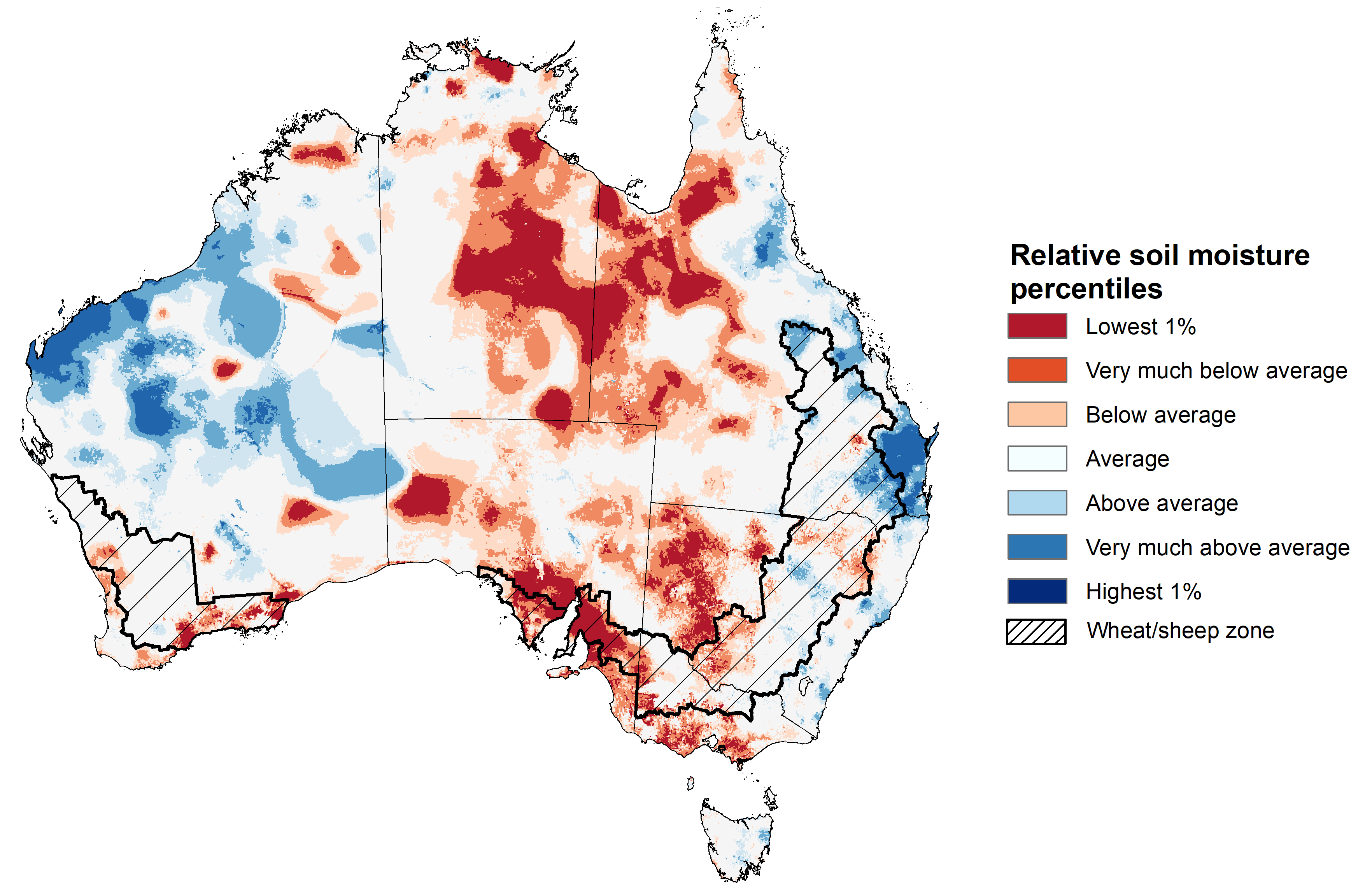
Source: Bureau of Meteorology (https://awo.bom.gov.au/about/overview)
Pasture growth for the three months to January 2025 has been mixed across much of Australia, with northern parts of the country experiencing stronger pasture growth.
- Average to extremely high pasture growth was modelled across much of northern and central Australia, including the Northern Territory, northern and eastern Queensland, and much of Western Australia.
- Average to above average pasture growth was observed in northern Victoria, south-eastern and western New South Wales and across much of South Australia.
This pasture growth is expected to support farmers maintaining stock numbers, provide opportunities to build standing dry matter availability and replenish fodder supplies during late spring and early summer.
By contrast, large areas of eastern and southern Australia saw relatively low pasture growth for this time of year.
- Extremely low to below average pasture growth was modelled across much of Tasmania, northern New South Wales, southern Victoria, southern South Australia and part of southern Western Australia and western Queensland.
This lower pasture growth will likely see graziers in affected regions actively destocking or increased reliance on supplemental feed to maintain current stocking rates and production.
Relative pasture growth for 3-months ending January 2025 (1 November to 31 January 2025)
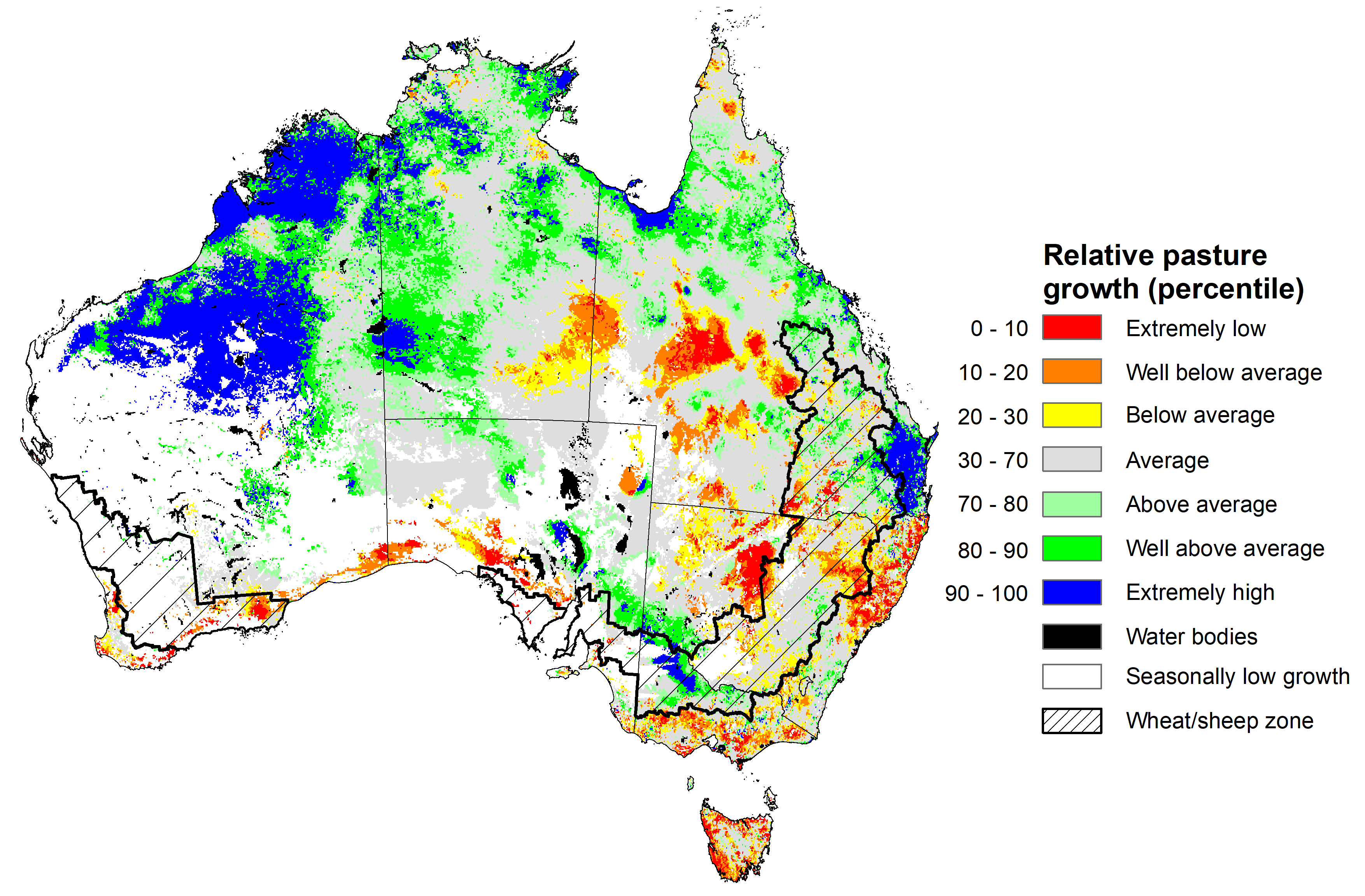
Source: Department of Environment, Science and Innovation
Water
Water storages, water markets and water allocations - current week
The Tableau dashboard may not meet accessibility requirements. For information about the contents of these dashboards contact ABARES.
Commodities
Information on weekly price changes in agricultural commodities is now available at the Weekly commodity price update.
